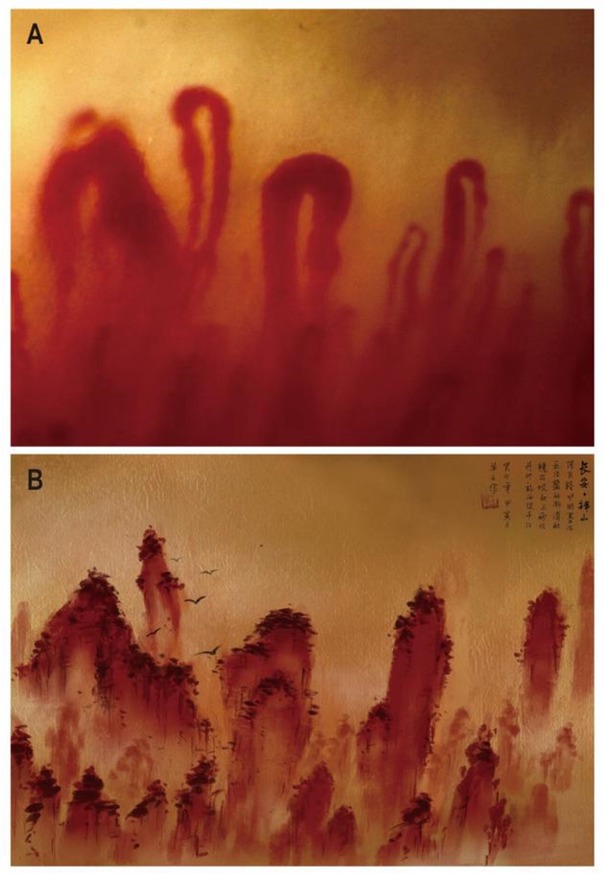A 65-year-old man presented with a two-year history of Raynaud’s phenomenon (RP) and a ten-month history of rapidly progress of skin swelling and hardening. Autoantibody testing revealed positivity for antinuclear antibodies (1: 1000) and anti-Scl70 antibodies, baseline serum creatine and blood pressure were normal. Nailfold capillaroscopy (NC) examination demonstrated decreased capillary density, along with enlarged (giant) capillaries, perivascular effusion, hemorrhage, and slowed blood flow (Figure 1A). Upon the diagnosis of diffuse cutaneous systemic sclerosis (SSc), the patient sought care at a local hospital, where he initiated treatment with prednisone (30 mg/d). However, he returned to our institution two weeks later, due to the possibility of a scleroderma renal crisis with weakness, elevated blood pressure, chest distress, nausea and increased serum creatinine.

Nailfold capillary of the patient. (A) Nailfold capillaroscopy image of SSc patient; (B) Reproduction of (A) in traditional Chinese painting.
The aberrant blood capillaries observed in patients with SSc (Figure 1A), exhibit a striking resemblance to the intricate landscapes depicted in traditional Chinese paintings (Figure 1B). The capillaries intricately shape a myriad of mountain-like forms, and the perivascular effusion conjures an analogy to the veiling mist enveloping mountains, thereby intensifying the air of mystique. Furthermore, the hemorrhaging can be likened to the presence of dense bushes or trees adorning mountainous terrain.
As a non-invasive method, NC is a valuable way to predict the evolution of Rp and digital ulcers, facilitate SSc diagnosis, and offer insights into disease prognosis.[1,2] In the context of our patient, the distinctive microvascular alterations observed by NC examination may light signals for kidney injury in the patient who suffered rapidly progression of skin sclerosis, and the subsequent administration of glucocorticoids may serve as a triggering factor for the onset of renal crisis. Consequently, in cases of SSc patients demonstrating rapidly involvement of skin, even displayed with anti-Scl70 positivity, the presence of characteristic microvascular damage might be predictive to the kidney crisis. Careful consideration should be given to the utilization of glucocorticoid therapy due to its potential implications.
Funding statement: This work was supported by the Joint Sino-German research project from National Natural Science Foundation of China (NSFC) and Deutsche Forschungsgemeinschaft (DFG, German Research Foundation) (Award Number: 82161138022).
Acknowledgments
Thanks to Shanyu Tu from Shanghai Maritime University for the Chinese painting.
-
Author Contributions Wenjing Ye, Ling Cao: Conceptualization, Writing—Original draft preparation, Writing—Reviewing and Editing. Yingzi Zhou, Yu Xue, Weiguo Wan, Hejian Zou: Conceptualization, Supervision. Xiaoxia Zhu: Supervision, Project administration.
-
Ethics Approval Not applicable.
-
Informed Consent Written informed consent was obtained from the participants.
-
Conflict of Interest The authors declare no competing interest.
-
Data Availability Statement Not applicable.
References
[1] Sulli A, Paolino S, Pizzorni C, et al. Progression of nailfold capillaroscopic patterns and correlation with organ involvement in systemic sclerosis: a 12 year study. Rheumatology (Oxford). 2020;59:1051–1058.10.1093/rheumatology/kez374Search in Google Scholar PubMed
[2] van Leeuwen N, Ciaffi J, Schoones J, et al. The contribution of sex and auto-antibodies to microangiopathy assessed by nailfold videocapillaroscopy in systemic sclerosis: A systematic review of the literature. Arthritis Care Res (Hoboken). 2021;73:722–731.10.1002/acr.24149Search in Google Scholar PubMed PubMed Central
© 2023 Wenjing Ye, Ling Cao, Yingzi Zhou, Yu Xue, Weiguo Wan, Hejian Zou, Xiaoxia Zhu, published by De Gruyter on behalf of NCRC-DID.
This work is licensed under the Creative Commons Attribution 4.0 International License.
Articles in the same Issue
- Editorial
- Lupus clinical trials and the promise of future therapies
- Guideline and Recommendations
- 2022 Chinese guideline for the management of pregnancy and reproduction in systemic lupus erythematosus
- Review
- Peptide-based immunotherapy in lupus: Where are we now?
- Low-dose interleukin-2 therapy in systemic lupus erythematosus
- Original Article
- East-Asian lupus nephritis in the Hopkins Lupus Cohort
- Special Article
- Improve quality of patient care for systemic lupus erythematosus in China by enhancing the construction of Centers of Excellence
- Case Report
- Seronegative enthesoarthritis as the first presentation of the atrial myxoma
- Image
- Active pattern on nailfold capillaroscopy in a patient with systemic sclerosis
- Letter to the Editor
- A rare condition that mimic myopathy: Late-onset glutaric acidaemia type II
Articles in the same Issue
- Editorial
- Lupus clinical trials and the promise of future therapies
- Guideline and Recommendations
- 2022 Chinese guideline for the management of pregnancy and reproduction in systemic lupus erythematosus
- Review
- Peptide-based immunotherapy in lupus: Where are we now?
- Low-dose interleukin-2 therapy in systemic lupus erythematosus
- Original Article
- East-Asian lupus nephritis in the Hopkins Lupus Cohort
- Special Article
- Improve quality of patient care for systemic lupus erythematosus in China by enhancing the construction of Centers of Excellence
- Case Report
- Seronegative enthesoarthritis as the first presentation of the atrial myxoma
- Image
- Active pattern on nailfold capillaroscopy in a patient with systemic sclerosis
- Letter to the Editor
- A rare condition that mimic myopathy: Late-onset glutaric acidaemia type II

